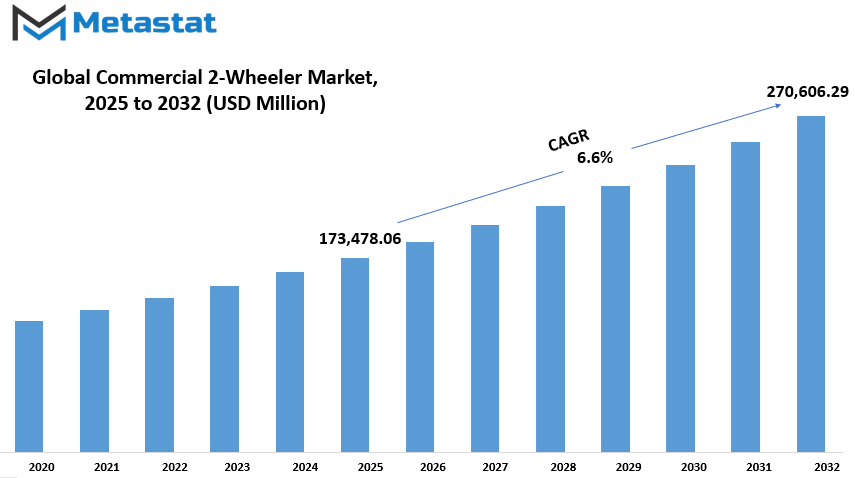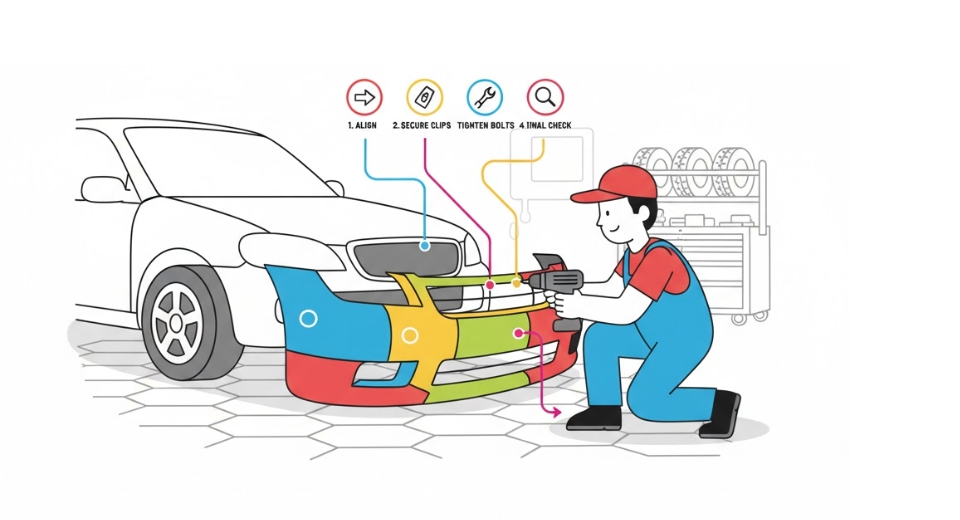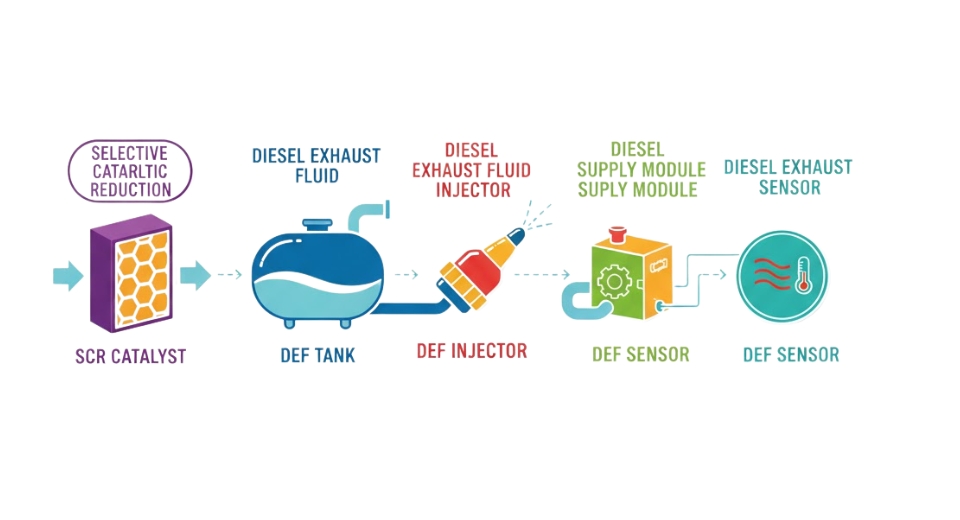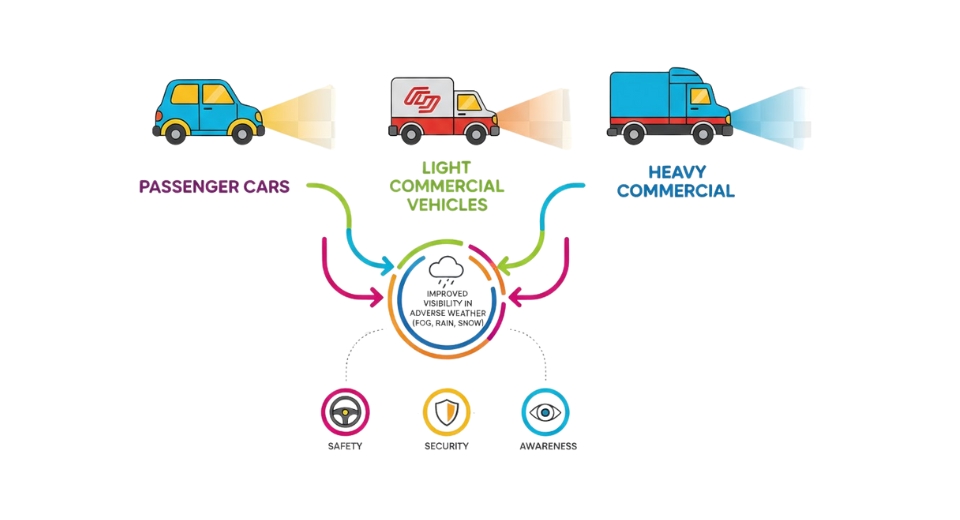MARKET OVERVIEW
The Global Commercial 2-Wheeler market occupies an important position in the transportation and logistics sector. It caters to a wide range of business requirements from the delivery of goods to passenger transport. The commercial two-wheeler market is essentially a market of motorized two-wheelers used for commercial purposes, and its prime difference from the personal-use segment is on utility, durability, and efficiency. Two-wheelers built for personal use are not meant to be put under severe usage like those of businesses, which function across the urban and rural spectrum.
As there are issues with traffic congestions, lack of parking space, and other problems in the densely populated area, the demand for commercial two-wheelers will increase further as the world is moving towards more sustainable and cost-effective solutions. Its significant role will be seen in last-mile connectivity, especially in e-commerce, food delivery, and courier services. This makes two-wheelers the preferred option when trying to optimize logistics for an enterprise that navigates through narrow roads and busy urban areas.
Technological advancement will change the face of the Global Commercial 2-Wheeler market, as leading players will develop more advanced engines such as electric propulsion systems, smart connectivity options, and additional safety mechanisms. Electric two-wheelers specifically will gain momentum due to the need for reduced carbon emissions within the international market. More efficient operation combined with environmental regulation alignment and corporate social responsibility will attract businesses to the same products.
Geographically, this market is characterized by diverse dynamics influenced by varying levels of industrialization, infrastructure, and government policies. In developing nations, commercial two-wheelers are often integral to micro-entrepreneurs and small-scale businesses, enabling economic participation at grassroots levels. Meanwhile, developed economies might focus more on premium technologies, including autonomous and connected two-wheelers designed for specific business applications.
The regulatory environment will significantly impact the future of the Global Commercial 2-Wheeler market. As sustainable practices become paramount for governments globally, incentives to electric vehicles, along with tougher emissions standards, will have implications on production trends and consumer preference. Manufacturers would need to act quickly to balance the compliance requirement with competitive pricing and technological innovation for relevance in the increasingly challenging landscape.
Digital platforms are yet another factor that is likely to influence the market. Companies are increasingly using data analytics, fleet management software, and integrated delivery systems for optimal operation. Therefore, commercial two-wheelers will also be designed in response to these technological changes with features suited for integration into smart logistics networks.
The Global Commercial 2-Wheeler market's competitive landscape is going to be dynamic where established and new players will have an interdependent role to play in the market. This encourages further innovation through design, performance, and cost efficiency. The manufacturing and business tie-ups would define the procurement models with customized solutions turning out to become a burgeoning trend.
The Global Commercial 2-Wheeler market will be a transformative segment, determined by technological advances, regulatory change, and new business needs. It will both respond to modern challenges in logistics but also create a new set of standards in commercial transportation for the world at large. Such evolution will mark the market as the bedrock on which companies rely for future reliable, flexible, and sustainable transport solutions.
Global Commercial 2-Wheeler market is estimated to reach $270,606.29 Million by 2032; growing at a CAGR of 6.6% from 2025 to 2032.

GROWTH FACTORS
The global commercial 2-wheeler market around the world is growing rapidly and mainly driven by e-commerce with last-mile delivery needs. This has resulted from an increasing amount of expansion that businesses have started adopting as means of efficient transportation, considering the relatively quicker and lower-cost way through which they would get to serve their customers using commercial 2-wheelers. The said vehicles are the most convenient and best-suited for use in towns. Due to their small size and flexibility in maneuvering, 2-wheelers have been a more convenient option for companies to satisfy the rising need for fast and efficient deliveries.
Another reason behind the growth of the market is the growing need for cost-effective transportation in urban cities. As the city becomes crowded and traffic congests, it becomes very expensive to run bigger vehicles. Commercial 2-wheelers are more economical for businesses; therefore, businesses can cut operational expenses without losing the efficiency of delivery services. Commercial 2-wheelers consume lesser fuel and require minimum maintenance, so they are one of the options companies opt for when they wish to cut costs to fulfill customer needs.
The market also has various challenges. High fuel prices, in particular, pose a serious challenge, since this affects the commercial cost of 2-wheelers directly. This might eventually increase delivery costs, thus further challenging profitability. In addition, tight emission rules and increasing environmental pressures are becoming critical issues. Globally, governments are enforcing more stringent rules to reduce pollution, and companies might find it hard to abide by these rules without significant investments in cleaner technologies.
However, despite the challenges, there are bright prospects for growth in the market. The most important areas for expansion would be the development of electric commercial 2-wheelers. Companies might find in electric 2-wheelers the route to the attainment of lessened carbon footprint at all costs as new generations come out with greater urgency toward fast delivery times and faster routes.
Further, operating them appears to incur costs lower compared with their conventional petrol-burning variants, helping achieve stringent new standards for lower emission levels. Adoption of electric 2-wheelers is expected to rise in coming years with further improvements in technology and declining prices and hence will form lucrative opportunities for the companies.
Conclusion The increasing demand for efficient and cost-effective transportation, in addition to the emerging electric vehicle market, is significant and promising for the future. There are considerable obstacles standing against commercial 2-wheelers from expanding the global market. As changes become an absolute element of the market, businesses will thrive by staying with these changes.
MARKET SEGMENTATION
By Type
The global commercial 2-wheeler market is expanding fast. Electric, internal combustion engine (ICE), and hybrid 2-wheelers are increasingly finding their places in different parts of the world. This market will look quite different in the near future as consumers and industries seek more sustainable alternatives. Among these, electric 2-wheelers are gaining strong traction. Market value for electric 2-wheelers- $46,699.93 million- affords cleaner alternatives to traditional vehicles.
It is a highly respected power source in terms of environmental impact, minimal maintenance costs, and lesser dependence on fossil fuels. The growing demand for EVs as awareness for environmental causes and government policies supporting green technologies are fueling the market for electric 2-wheelers.
On the contrary, 2-wheelers propelled by the internal combustion engine are on top of most regions in particular in developing nations. The kind of powertrain that has been available for years is the affordability along with reliable performance and an extensively entrenched infrastructure has been in ICE 2-wheelers. As they happen to be the easy means of reaching any location from one point of the world, they maintain an important share in the global market.
Even though electric alternatives are picking up, the ICE vehicles still have a strong presence especially in regions that are slower with the adoption of electric vehicles for reasons such as limited charging infrastructure or cost barriers.
Hybrid 2-wheelers, where the benefits of both electric and ICE technology are taken together, constitute another important market segment. Hybrid 2-wheelers thus present a well-balanced proposition to consumers whereby they enjoy all the advantages of electric mobility and yet do not completely forsake the dependability of an internal combustion engine. With market progression, hybrid 2-wheelers are also catching up with varied consumer comfort levels.
They provide a gateway option for the consumers, who are not yet ready to switch over to the pure electric models but would still like to enjoy the merits of lower emissions and better fuel efficiency.
The global commercial 2-wheeler market is highly dynamic and rising with the various types of vehicles offering distinct advantages. Electric 2-wheelers are building a way towards sustainable transportation. The internal combustion engine and hybrid 2-wheelers continue to satisfy the consumers' needs in the different markets. With technology advancement, more investments, and change in consumer preference, the market will be expanding, giving way to greater options and solutions for transportation in the future years.
By Sales Channel
The global commercial 2-wheeler market is influenced by various sales channels, such as direct sales, dealerships, online sales, fleet sales, and leasing companies. Each of these sales channels plays a significant role in the distribution and availability of 2-wheelers for commercial use.
Direct sales are one of the primary methods where manufacturers sell their products directly to the customers. This way, the companies are better in charge of the price and the customer experience. It is a more customized process and typically involves tailored sales, which could be advantageous to the buyer as well as the seller. Direct sales are especially significant in regions where customers prefer to connect directly with the manufacturer or where specific brands have established a robust direct-to-consumer presence.
The dealerships are the other prominent entities in the commercial 2-wheeler market. They are considered intermediaries between the manufacturers and end customers. The dealerships provide an array of 2-wheelers to the customer and, as is often seen, provide after-sales services in the form of maintenance and repair services. It becomes crucial for those customers who would like to see and test the vehicle or would need continuous service support. Dealerships can act as gateway locations for exposing multiple models of 2-wheelers to various commercial purposes and spread over different regions.
Online sales have also altered the market scenario in the last few years. With rapid internet penetration and rising ease of online shopping, most customers today buy 2-wheelers from the internet. These channels have a vast array of choices, easy price comparisons, and often competitive offers. Customers can browse various models, read reviews, and buy from the comfort of their home. As e-commerce emerges, online sales have become an important channel for both old stalwarts and new entrants.
Fleet sales include selling multiple units of 2-wheelers to businesses for operational use, which is an important segment of the market. Businesses need a fleet of vehicles for delivering services, transportation, or logistics. The demand for these is fulfilled through fleet sales. Fleet sales include bulk purchases with special deals and customized packages. Even leasing companies have come into the spotlight by providing flexible leasing options.
This helps the business in availing of the commercial 2-wheelers for rent rather than full-time ownership. Leasing is particularly attractive to those companies that need flexibility in scaling fleets up or down according to market demand.
The commercial 2-wheeler market is supported through various sales channels, each catering to different customer needs. These sales channels include direct sales, dealerships, online platforms, fleet sales, and leasing companies, all of which play a very important role in ensuring that the right businesses and individuals have access to commercial 2-wheelers.
By Application
The global commercial 2-wheeler market is growing rapidly in response to the increasingly high demand coming from various sectors. As it continues to grow and evolve, more applications of the 2-wheelers are appearing and becoming integral for various commercial functions. The 2-wheeler market may be divided into many key applications, playing a critical role in different business activities.
The largest segment is delivery services. As these e-commerce and food delivery sectors grow, 2-wheelers have become integral to the growth of the demand for efficient and fast, yet relatively inexpensive, transport. They answer the practical quest to navigate heavy urban streets by delivering goods, which makes it a staple around the world among delivery companies for businesses to smooth out their operations while reaching customers quickly.
Ride-hailing services are another very significant segment. Platforms like Uber and Lyft have completely changed the face of travel. For many, motorcycles or scooters are now becoming a popular mode of transport. Their agility through traffic and the ease with which they can reach places faster than cars make them very attractive for ride-hailing drivers and customers. The demand for affordable, on-demand transportation in the densely populated areas is, in fact boosting this segment in growth. The main reason being traffic congestion common in such a region.
In corporate fleets, this plays a huge role in the market because many companies use 2-wheelers to take their employees around, conduct site visits, or facilitate company logistics. Affordability and flexibility make them a good source for companies looking to control the cost of moving employees without sacrificing speed and dependability.
Another significant trend is the growing use of 2-wheelers by police and security forces worldwide. It helps them reach the site quickly in case of an emergency, cut through traffic, and patrol areas with much ease. Hence, it is one of the tools for law enforcement and security personnel. This market will continue to grow as more police departments and security companies discover the benefits of using 2-wheelers in their operations.
Courier and postal services are highly utilizing the commercial 2-wheeler market. These services depend heavily on two-wheelers for delivering letters, packages, and parcels quickly. Both motorcycles and scooters are appropriate for this purpose since they are smaller in size and consume less amount of fuel. Hence, on streets where big sized vehicles will not be able to pass, motorcycles and scooters are highly suitable.
Now, rentals and leasing services are becoming very popular, especially in urban centers. This is because for a small period of time, one can hire a 2-wheeler and use the same to run around his or her errands, commute, or for leisurely purposes. The reason is that access is easy, and hiring or leasing a motorcycle or scooter is cost-effective. This, in turn, influences the overall commercial 2-wheeler market through its varied applications and has contributed to a rise in the demand for such vehicles globally.
By End-User
The global commercial 2-wheeler market is a highly significant contributor for several sectors together, which each contribute to demand and usage in these vehicles. These 2-wheelers particularly gain popularity across regions where factors such as efficiency, low running costs, and agility are the critical advantages. Various end-users will be categorized based on the classification of the global commercial 2-wheeler market, ranging from logistics companies, e-commerce companies, ride-hailing companies, government, and municipalities to corporate enterprises, and rental agencies.
Logistics companies dominate the commercial 2-wheeler market. These 2-wheelers are used by almost every logistics company for last-mile delivery because they easily navigate congested urban spaces, saving more time and fuel. Because of their size, it is perfectly suitable to carry goods over short distances, which is a requirement for logistics operations in crowded cities. The growing need for quickening delivery time has compelled logistics companies to rely ever more on these vehicles.
E-commerce firms are another critical end-user of commercial 2-wheelers. E-commerce is constantly on the rise, and speed and efficiency are essential in this delivery system. E-commerce firms depend highly on commercial 2-wheelers for transporting goods to customers, mainly in urban, high-density population areas. With these vehicles, companies can get to their customers fast while still keeping delivery expenses low.
Ride-hailing companies are also driving the commercial 2-wheeler market. The rise in ride-hailing services for both passengers and deliveries increases the demand for 2-wheelers. It is a convenient mode of transport for individuals and small deliveries, particularly in countries that face traffic congestion.
Commercial 2-wheelers are commonly used by governments and municipalities for varied purposes that include public transport, emergencies, and law enforcement. This is because they are flexible and cheap to operate in an urban setting where large vehicles may not be as practical.
More and more, corporate enterprises use 2-wheelers in their corporate fleets for intracity transportation needs, to transport employees, or to make deliveries within business districts. They prefer these vehicles as they are less expensive and much easier to operate in the congested urban terrain.
Rental agencies also provide commercial 2-wheelers that can be taken for short periods to the market. This is beneficial in cities for people who would need temporary modes of transport due to business dealings or short-distance deliveries. The rental market fills a gap for someone who does not have a commercial 2-wheeler but, at times, needs one.
The global commercial 2-wheeler market is growing rapidly with the diversified demands of various industries. Continuous demands for cost-effective, efficient, and fast modes of transportation have made these vehicles a key component for many businesses around the globe.
|
Forecast Period |
2025-2032 |
|
Market Size in 2025 |
$173,478.06 million |
|
Market Size by 2032 |
$270,606.29 Million |
|
Growth Rate from 2024 to 2031 |
6.6% |
|
Base Year |
2024 |
|
Regions Covered |
North America, Europe, Asia-Pacific, South America, Middle East & Africa |
REGIONAL ANALYSIS
The global commercial 2-wheeler market is segmented by geography into North America, Europe, Asia-Pacific, South America, and the Middle East & Africa. Further breakdowns are given for each of these regions, enabling further understanding of the market's dynamics.
North America incorporates the United States, Canada, and Mexico. In this regard, the region leads with a dominant commercial 2-wheeler demand due to increased demand in delivering services coupled with the up-coming of more environmentally conscious modes of transport. The demand of the region toward commercial 2-wheelers stems from urban mobility problems and further surging necessities to have shorter-range delivery needs through efficient options of transportation.
Europe is another significant market for commercial 2-wheelers, with the United Kingdom, Germany, France, Italy, and the rest of Europe contributing to its growth. The European market is driven by factors such as increasing concerns over pollution, rising fuel costs, and the need for efficient transportation in dense urban areas. In particular, Germany and France have seen substantial adoption of 2-wheelers for commercial use, especially in logistics and delivery sectors.
The commercial 2-wheeler market is the largest and fastest-growing region, consisting of Asia-Pacific, which includes India, China, Japan, South Korea, and the rest of Asia-Pacific. This region boasts a high population density, increased urbanization, and the ever-growing demand for delivery services, making 2-wheelers a perfect fit for businesses.
China and India, in particular, have been leaders in the adoption of commercial 2-wheelers because of the size of their markets and their growing e-commerce sectors. Japan and South Korea also have important markets, but there is an increasing trend towards electric 2-wheelers in these countries as part of a greener transportation policy.
South America encompasses Brazil, Argentina, and all other countries. South America has experienced a surge in demand for commercial 2-wheelers, driven by businesses that are looking for low-cost, fuel-efficient means to speed up delivery while minimizing costs. Huge urban agglomerations across the region form a major reason for this market. Small-scale business operations, among others, have increased in using 2-wheelers for several commercial activities.
Middle East & Africa is the other important region, segmented into GCC countries, Egypt, South Africa, and the rest of the region. In this region, the market drivers are the ever-increasing requirement for transportation solutions in urban and semi-urban areas, e-commerce, and the delivery services market. South Africa, Egypt, and the GCC countries have substantial growth potential for the commercial 2-wheeler market.
Overall, in different regions worldwide, the various demands and unique needs shape their respective commercial markets for 2-wheelers while varying factors bring these vehicles in use for different purposes.

COMPETITIVE PLAYERS
Global commercial 2-wheeler markets consist of major players who form the core in this industry and are the leading contributors to growth and development. Such companies include Honda Motor Co., Ltd., Yamaha Motor Co., Ltd., Hero MotoCorp Ltd., and Bajaj Auto Ltd., at the top in the market. All these companies produce motorcycles and scooters for the variety of consumer demands. These companies are well regarded for being quality-focused and innovative in their product, which sustains their position in the market.
There are also companies like TVS Motor Company and Suzuki Motor Corporation, which occupy good market shares. These firms are known for their engineering skills and understanding of the type of vehicle that is marketed, be it by businesses or to individual consumers. TVS has earned a reputation for providing value for money and has been one of the favorite brands for commercial buyers. Suzuki, on the other hand, is known for its high-tech and fuel-efficient products, which have helped it become one of the preferred brands in the commercial 2-wheeler market.
Other key players in this industry are Harley-Davidson, Inc., Piaggio & C. SpA, and KTM AG, which are concentrated on the high-end market. Harley-Davidson is famous for its iconic motorcycles, while Piaggio is known for its scooters, including the legendary Vespa. KTM has gained a good following with its high-performance bikes among commercial and recreational riders.
Within recent years, demand for electric two-wheelers has gone up dramatically. Ather Energy, NIU Technologies, and Gogoro Inc. are the most significant beneficiaries of this shift. The firms are leaders in the electric 2-wheeler market with a promise to deliver a cleaner and greener alternative to gasoline-based motorcycles and scooters. These players are gearing up for a long-term lead in an increasingly environmentally aware world as electric vehicles gain acceptance.
Other significant players are Mahindra & Mahindra Ltd. (Two-Wheelers), Royal Enfield, and Vespa-since these companies are continually widening their presence in the global commercial 2-wheeler market. With innovation, efficiency, and customer satisfaction as focus areas, such companies have played a significant role in molding the future of the industry. Efforts to launch new models and enhance the customer experience ensure that they remain at par with the dynamic nature of this market.
In conclusion, a diversified group of companies dominates the global commercial 2-wheeler market with their unique strengths and innovations. These players continue to drive the growth and development of the industry through a wide variety of products to cater to commercial and individual needs. As demand for electric vehicles increases, these companies will likely continue to play a significant role in shaping the future of the commercial 2-wheeler market.
Commercial 2-Wheeler Market Key Segments:
By Type
- Electric 2-Wheelers
- Internal Combustion Engine (ICE) 2-Wheelers
- Hybrid 2-Wheelers
By Sales Channel
- Direct Sales
- Dealerships
- Online Sales
- Fleet Sales
- Leasing Companies
By Application
- Delivery Services
- Ride-Hailing Services
- Corporate Fleets
- Police and Security
- Courier and Postal Services
- Rentals and Leasing
By End-User
- Logistics Companies
- E-commerce Companies
- Ride-Hailing Companies
- Government and Municipalities
- Corporate Enterprises
- Rental Agencies
Key Global Commercial 2-Wheeler Industry Players
- Honda Motor Co., Ltd.
- Yamaha Motor Co., Ltd.
- Hero MotoCorp Ltd.
- Bajaj Auto Ltd.
- TVS Motor Company
- Suzuki Motor Corporation
- Harley-Davidson, Inc.
- Piaggio & C. SpA
- KTM AG
- Ather Energy
- NIU Technologies
- Gogoro Inc.
- Mahindra & Mahindra Ltd. (Two-Wheelers)
- Royal Enfield
- Vespa
WHAT REPORT PROVIDES
- Full in-depth analysis of the parent Industry
- Important changes in market and its dynamics
- Segmentation details of the market
- Former, on-going, and projected market analysis in terms of volume and value
- Assessment of niche industry developments
- Market share analysis
- Key strategies of major players
- Emerging segments and regional growth potential











 US: +1 3023308252
US: +1 3023308252






